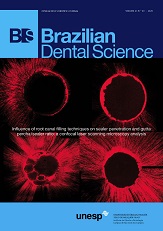Failure of miniscrews installed in maxilla and mandible: a systematic review and meta-analysis
DOI:
https://doi.org/10.14295/bds.2020.v23i3.2049Abstract
Objective: The aim of this systematic review was to compare the clinical failure rate of orthodontic miniscrews in maxilla and mandible. Material and Methods: Randomized controlled trials of patients in orthodontic treatment, which required miniscrews for orthodontic intervention reporting the failure rate of miniscrews in the maxilla and mandible were searched in Pubmed database. Two authors independently reviewed all identified titles and abstracts for eligibility. Comparison between failures in maxilla and mandible were estimated using pairwise meta-analysis to calculate the relative risk (RR) of failure and the 95% confidence intervals using a random-effect model. The reports of randomized trials were assessed for bias using the Cochrane risk of bias tool. Results: Four studies fulfilled the eligibility criteria. 299 patients with a total of 628 miniscrews installed were included in the analysis. The analysis showed a 0.55 RR (95% CI 0.23–1.29) and I2 = 85%. All studies had an unclear risk of bias regarding to the two following items: allocation concealment, blinding of participants and personnel. All studies had a low risk of bias with regard to incomplete outcome data and selective reporting. The results did not demonstrate statistical difference between risk of failure of miniscrew between maxilla and mandible. Conclusion: The results of the meta-analysis showed that miniscrews installed in maxilla presents reduced risk of failure. A tendency of higher number of failures in mandible was also demonstrated. However, results should be interpreted with caution because of the very low quality of included studies and the differences among methodologies.
Keywords
Meta-analysis; Orthodontic anchorage procedures; Review.
Downloads
References
Gray JB, Smith R. Transitional implants for orthodontic anchorage. J Clin Orthod. 2000;34:659-66. PMID: 11314544
Chen CH, Chang CS, Hsieh CH, Tseng YC, Shen YS, Huang IY, et al. The use of microimplants in orthodontic anchorage. J Oral Maxillofac. Surg 2006;64:1209-13. doi: 10.1016/j.joms.2006.04.016.
Huang LH, Shotwell JL, Wang HL. Dental implants for orthodontic anchorage. Am J Orthod Dentofacial Orthop. 2005;127:713-22. doi: 10.1016/j.ajodo.2004.02.019.
Park HS, Bae SM, Kyung HM, Sung JH. Micro-implant anchorage for treatment of skeletal Class I bialveolar protrusion. J Clin Orthod. 2001;35:417-22. PMID: 11494827.
Park HS, Jeong SH, Kwon OW. Factors affecting the clinical success of screw implants used as orthodontic anchorage. Am J Orthod Dentofacial Orthop. 2006;130:18-25. doi: 10.1016/j.ajodo.2004.11.032.
Papadopoulos MA, Tarawneh F. The use of miniscrew implants for temporary skeletal anchorage in orthodontics: a comprehensive review. Oral Surg Oral Med Oral Pathol Oral Radiol Endod 2007;103:e6-15. doi: 10.1016/j.tripleo.2006.11.022.
Higgins JPT GS, editors. Cochrane Handbook for Systematic Reviews of Interventions Version 5.1.0: The Cochrane Collaboration; 2011. Available from www.cochrane-handbook.org.
Panic N, Leoncini E, de Belvis G, Ricciardi W, Boccia S. Evaluation of the endorsement of the preferred reporting items for systematic reviews and meta-analysis (PRISMA) statement on the quality of published systematic review and meta-analyses. PLoS One 2013;8:e83138. doi: 10.1371/journal.pone.0083138.
Alharbi F, Almuzian M, Bearn D. Miniscrews failure rate in orthodontics: systematic review and meta-analysis. Eur J Orthod 2018. doi: 10.1093/ejo/cjx093.
Cunha AC, da Veiga AMA, Masterson D, Mattos CT, Nojima LI, Nojima MCG, et al. How do geometry-related parameters influence the clinical performance of orthodontic mini-implants? A systematic review and meta-analysis. Int J Oral Maxillofac Surg 2017;46:1539-51. doi: 10.1016/j.ijom.2017.06.010.
Higgins JP, Altman DG, Gotzsche PC, Juni P, Moher D, Oxman AD, et al. The Cochrane Collaboration's tool for assessing risk of bias in randomised trials. BMJ 2011;343:d5928. doi: 10.1136/bmj.d5928.
Balshem H, Helfand M, Schunemann HJ, Oxman AD, Kunz R, Brozek J, et al. GRADE guidelines: 3. Rating the quality of evidence. J Clin Epidemiol 2011;64:401-6. doi: 10.1016/j.jclinepi.2010.07.015.
Garfinkle JS, Cunningham LL Jr, Beeman CS, Kluemper GT, Hicks EP, Kim MO. Evaluation of orthodontic mini-implant anchorage in premolar extraction therapy in adolescents. Am J Orthod Dentofacial Orthop 2008;133:642-53. doi: 10.1016/j.ajodo.2006.04.053.
Wiechmann D, Meyer U, Buchter A. Success rate of mini- and micro-implants used for orthodontic anchorage: a prospective clinical study. Clin Oral Implants Res 2007;18:263-7. doi: 10.1111/j.1600-0501.2006.01325.x.
Suzuki M, Deguchi T, Watanabe H, Seiryu M, Iikubo M, Sasano T, et al. Evaluation of optimal length and insertion torque for miniscrews. Am J Orthod Dentofacial Orthop 2013;144:251-9. doi: 10.1016/j.ajodo.2013.03.021.
Yoo SH, Park YC, Hwang CJ, Kim JY, Choi EH, Cha JY. A comparison of tapered and cylindrical miniscrew stability. Eur J Orthod 2014;36:557-62. doi: 10.1093/ejo/cjt092.
Consolaro A, Romano FL. Reasons for mini-implants failure: choosing installation site should be valued! Dental Press J Orthod 2014;19:18-24. doi: 10.1590/2176-9451.19.2.018-024.oin.
Lim HJ, Eun CS, Cho JH, Lee KH, Hwang HS. Factors associated with initial stability of miniscrews for orthodontic treatment. Am J Orthod Dentofacial Orthop 2009;136:236-42. doi: 10.1016/j.ajodo.2007.07.030.
Downloads
Additional Files
Published
How to Cite
Issue
Section
License
Brazilian Dental Science uses the Creative Commons (CC-BY 4.0) license, thus preserving the integrity of articles in an open access environment. The journal allows the author to retain publishing rights without restrictions.
=================




























